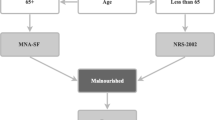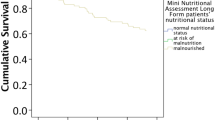Abstract
Objective: To assess the use of the Mini-Nutritional Assessment (MNA) in elderly orthopaedic patients.
Design: An observation study assessing the nutritional status of female orthopaedic patients.
Setting: The orthopaedic wards of the Royal Surrey County Hospital.
Subjects: Forty-nine female patients aged 60–103 y; dietary records were obtained for 41 subjects and 36 subjects gave a blood sample for biochemical analysis.
Major outcome methods: MNA questionnaire, anthropometry, plasma albumin, transferrin, C-reactive protein (CRP) levels and dietary analyses.
Results: The group as a whole had low mean values for body weight, albumin and transferrin and high CRP levels. In addition, the group had mean energy intakes well below the estimated average requirement (EAR) and mean intakes of vitamin D, magnesium, potassium, selenium and non-starch polysaccharides (NSP) were below the lower reference nutrient intakes (LRNI). The MNA screening section categorized 69% of the patients as requiring a full assessment (scored 11 or below), but for the purposes of the study the MNA was completed on all patients. The MNA assessment categorized 16% of the group as ‘malnourished’ (scored<17 points), 47% as ‘at risk’ (scored 17.5–23.5) and 37% as ‘well nourished’ (scored>23.5). Significant differences were found between the malnourished and well nourished groups for body weight (P<0.001), body mass index (BMI) (P<0.001), demiquet (P<0.001) and mindex (P<0.001). Mean values for energy and nutrient intakes showed a clear stepwise increase across the three groups for all nutrients except sodium, with significant differences for protein (P<0.05), carbohydrate (P<0.05), riboflavin (P<0.05) niacin (P<0.05), pyridoxine (P<0.05), folate (P<0.05), calcium (P<0.05), selenium (P<0.05), iron (P<0.05) and NSP (P<0.05) intakes. Stepwise multiple regression analysis indicated that anthropometric assessments were the most predictive factors in the total MNA score. The sensitivity and specificity of the MNA was assessed in comparison with albumin levels, energy intake and mindex. The sensitivity of the MNA classification of those scoring less than 17 points in comparison with albumin levels, energy intake and mindex varied from 27 to 57% and the specificity was 66–100%. This was compared with the sensitivity and specificity of using a score of less than 23.5 on the MNA to predict malnourished individuals. Using this cut-off the sensitivity ranged from 75 to 100%, but the specificity declined to between 37 and 50%.
Conclusions: The results suggest that the MNA is a useful diagnostic tool in the identification of elderly patients at risk from malnutrition and those who are malnourished in this hospital setting.
Sponsorship: Nestlé Clinical Nutrition, Croydon, Surrey.
European Journal of Clinical Nutrition (2000) 54, 555–562
This is a preview of subscription content, access via your institution
Access options
Subscribe to this journal
Receive 12 print issues and online access
$259.00 per year
only $21.58 per issue
Buy this article
- Purchase on Springer Link
- Instant access to full article PDF
Prices may be subject to local taxes which are calculated during checkout
Similar content being viewed by others
Author information
Authors and Affiliations
Contributions
Guarantor: MC Murphy.
Contributors: MCM was the main author, supervised the biochemical analyses and carried out the statistical analysis. MLL's experience in this patient group and the hospital setting initiated the research area and study by writing the project protocol, and she also supervised the project. CNB recruited the subjects and carried out the MNA interviews. SAN helped write the proposal, set up the database and also supervised the dietary analysis.
Corresponding author
Rights and permissions
About this article
Cite this article
Murphy, M., Brooks, C., New, S. et al. The use of the Mini-Nutritional Assessment (MNA) tool in elderly orthopaedic patients. Eur J Clin Nutr 54, 555–562 (2000). https://doi.org/10.1038/sj.ejcn.1601055
Received:
Revised:
Accepted:
Published:
Issue Date:
DOI: https://doi.org/10.1038/sj.ejcn.1601055
Keywords
This article is cited by
-
Prevalence of Poor Nutrition in Knee Osteoarthritis Patients: A Hospital-Based Cohort Study in Indian Population
Indian Journal of Orthopaedics (2024)
-
Nutritional Assessment in Older Adults: MNA® 25 years of a Screening Tool & a Reference Standard for Care and Research; What Next?
The Journal of nutrition, health and aging (2021)
-
Predicting non-elective hospital readmission or death using a composite assessment of cognitive and physical frailty in elderly inpatients with cardiovascular disease
BMC Geriatrics (2020)
-
Clinical measurement properties of malnutrition assessment tools for use with patients in hospitals: a systematic review
Nutrition Journal (2020)
-
Screening Community-Living Older Adults for Protein Energy Malnutrition and Frailty: Update and Next Steps
Journal of Community Health (2020)



